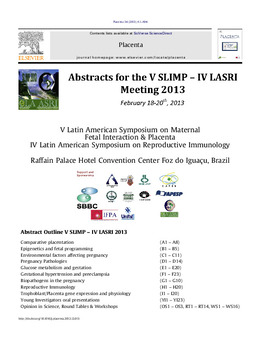| dc.contributor.author | Araya, Ornella | |
| dc.contributor.author | Triquell, María Fernanda | |
| dc.contributor.author | Díaz Luján, Cintia | |
| dc.contributor.author | Mezzano, Luciana | |
| dc.contributor.author | Piegari, Mariana | |
| dc.contributor.author | Fretes, Ricardo Emilio | |
| dc.date.accessioned | 2022-02-11T18:14:50Z | |
| dc.date.available | 2022-02-11T18:14:50Z | |
| dc.date.issued | 2013 | |
| dc.identifier.isbn | 0143-4004 | |
| dc.identifier.uri | http://hdl.handle.net/11086/22348 | |
| dc.description | 2p | es |
| dc.description.abstract | Human placenta participates in the control of Chagas congenital infection, which could be due by nitric oxide synthase (NOS) and peroxinitrites which are deleterious for Trypanosoma cruzi and placental tissue. We proposed to analyze the detachment of STB and its relation to oxidative stress and congenital transmission. Two experimental designs: In vitro: Placental villi explants co-cultured with and without T. cruzi. Ex vivo: placentas from chagasic mothers with (CT) and without (NC) congenital transmission. It was analyzed eNOS, Nitrotyrosine (NT) and detachment of STB. Detachment of STB was increased and induced by Tc and H2O2 in vitro, however it was not significantly higher in ex vivo placentas. These changes were associated to modifications in the expression of eNOS and NT both in vitro and ex vivo. The balance between deleterious effect on T. cruzi, and structural placental alterations produced by nitrosative stress, could participate in the infection of placenta by the parasite | es |
| dc.description.uri | http://www.placentajournal.org/article | |
| dc.format.medium | Impreso/ Digital | |
| dc.language.iso | eng | es |
| dc.publisher | V Latin American Symposium on Maternal Fetal Interaction & Placenta | es |
| dc.relation.ispartof | 11086/14404 | es |
| dc.rights | Attribution-NonCommercial-ShareAlike 4.0 International | * |
| dc.rights.uri | https://creativecommons.org/licenses/by-nc-sa/4.0/ | * |
| dc.subject | Placenta | es |
| dc.subject | Chagas | es |
| dc.title | Implications of oxidative stress and placental structural alterations in Trypanosoma cruzi infection in vitro and ex vivo | es |
| dc.type | conferenceObject | es |
| dc.description.fil | Fil: Araya, Ornella. Universidad Nacional de Córdoba. Facultad de Ciencias Médicas. Instituto de Biología Celular. Cátedra de Biología Celular, Histología y Embriología; Argentina. | es |
| dc.description.fil | Fil: Triquell, María Fernanda. Universidad Nacional de Córdoba. Facultad de Ciencias Médicas. Instituto de Biología Celular. Cátedra de Biología Celular, Histología y Embriología; Argentina. | es |
| dc.description.fil | Fil: Días Luján, Cintia. Universidad Nacional de Córdoba. Facultad de Ciencias Médicas. Instituto de Biología Celular. Cátedra de Biología Celular, Histología y Embriología; Argentina. | es |
| dc.description.fil | Fil: Mezzano, Luciana. Universidad Nacional de Córdoba. Facultad de Ciencias Médicas. Instituto de Biología Celular. Cátedra de Biología Celular, Histología y Embriología; Argentina. | es |
| dc.description.fil | Fil: Piegari, Mariana. Universidad Nacional de Córdoba. Facultad de Ciencias Médicas. Instituto de Biología Celular. Cátedra de Biología Celular, Histología y Embriología; Argentina. | es |
| dc.description.fil | Fil: Fretes, Ricardo Emilio. Universidad Nacional de Córdoba. Facultad de Ciencias Médicas. Instituto de Biología Celular. Cátedra de Biología Celular, Histología y Embriología; Argentina. | es |
| dc.description.field | Patología | |
| dc.conference.city | Londres | |
| dc.conference.country | Reino Unido | |
| dc.conference.editorial | Elsevier | |
| dc.conference.event | V SLIMP Latin American Symposium on Maternal-Fetal Interactions & Placenta and IV Latin American Symposium on Reproductive Immunology. 2013, pp 60. | |
| dc.conference.eventcity | Foz de Iguazú | |
| dc.conference.eventcountry | Brasil | |
| dc.conference.eventdate | 2013-2 | |
| dc.conference.institution | SLIMP | |
| dc.conference.journal | Placenta | |
| dc.conference.publication | Revista | |
| dc.conference.work | Resumen | |
| dc.conference.type | Congreso | |





